
It came to pass amidst some discussions about a year or so ago on a discussion list I sometimes frequent that the subject of a 'plasma capacitor' came up. What's that? Well, consider the ordinary capacitor, in very simplified form below:

We have two plates, upon which charge is accumulated or placed by some source of electric current, and a dielectric between the plates (in this case, air or vacuum, for simplicity's sake). When the conductive metal plates are charged, an electric field is set up between them, in the dielectric, and electrical energy is stored. This is a simplification, yes, but it's pretty sufficient for what we're going to look into here. The amount of electrical energy stored in the capacitor is given by:
E = 1/2 (C x V^2)
C is the capacitance in farads, V the voltage in volts, and E the energy stored in joules. Assuming a capacitor with a capacitance of 250pF (0.00000000025 farads, something like a 1 foot square pair of plates separated in air by 1/8th inch), and assuming we charge this capacitor to 100 volts, it will store about 1.25 microjoules. In other words, not a whole hell of a lot. But make that capacitor a big Maxwell beast of 10uF, and charge it to 10,000 volts, and you've stored half a kilojoule. That is not a small amount, and if you become the dissipator of said energy, expressed as a transient impulse of some significant power, you may very well die. If you are dead, you probably won't need to read any further, so my suggestion is to go find a nice place (hotel, old warship, etc.) and get busy haunting. If you're alive, continue. If you're undead... well, drop us a line and tell us if Kuru or Creutzfeldt-Jakob is a problem for you guys. Tris notes, "That's just sick."
Fine, we now know how to make a capacitor, which accomplishes very little, because all this has been done before. But let's take a closer look at the simple two-plate capacitor. The plates are usually metal, but can certainly be of some other conductive substance. Saltwater can work, if contained in a bottle with foil wrapped around the outside. The Tesla-coil enthusiasts know this quite well. (At least the ones who didn't switch to 'MMCs.' Come on guys, part of the fun is to make your own stuff Tesla style... storebought caps? Really?)
Carbon could work as a plate material. Even conductive polymers. But what about plasma? Ionized gas. Well, that's what we ended up discussing. As it turned out, from a simple experiment we at United Neko conducted, you can build a capacitor which has one plate made of plasma, and it's rather unsurprising. Plasma is a conductor. But the more we think about it, the more interesting the plasma capacitor starts to look. There might just be some fun things to do here.
Consider this simple circuit:
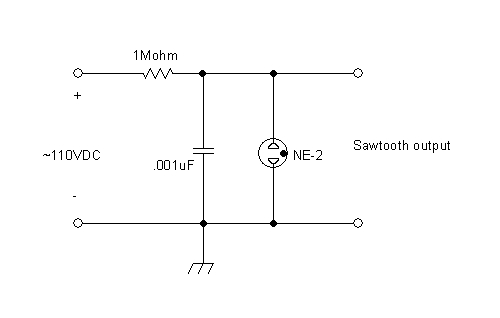

Many of you will recognize this as the ubiquitous relaxation oscillator. This basic circuit has been used for a number of things, providing a simply derived sawtooth wave from one of the most useful but often overlooked components ever made: the NE-2 neon bulb. Let's consider what happens: when voltage is applied to the above circuit, a charging current flows through the limiting resistor, charging the capacitor and increasing it's voltage. But a funny thing happens when the voltage reaches a certain level; the NE-2 has a breakdown or firing voltage which is less than that of the charging supply. When the capacitor's voltage reaches this threshold, the NE-2 ionizes internally, becoming conductive, and illuminates. This discharges the capacitor, reducing it's voltage. When that voltage falls below what is necessary for the NE-2 to stay lit, it goes out, returning to a nonconducting state. The capacitor begins to charge once more, and the process repeats indefinitely, making a simple oscillator. A photograph of an oscilloscope trace showing this circuit's output is show here:
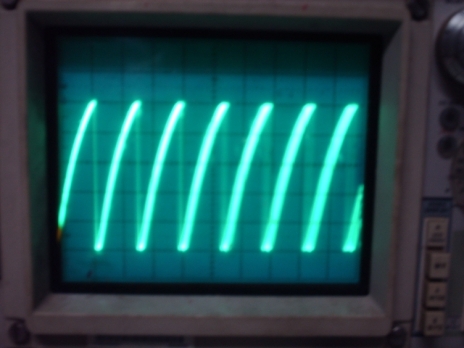
Why is the circuit important? Well, let's just remove the factory made capacitor "C" from the circuit, and put a would-be plasma capacitor in it's place, and see if it still works. First, however, we must build said plasma capacitor. My muse suggests we need "An enclosed glass vessel, filled with an easily ionizable rarified gas or vapor of some kind, an integral heater-filament to assist in ionizing said gas, and suitable electrodes for contacting and controlling said gas and allowing it to transition to a plasma state!"
. . .
In other words, we can use a fluorescent light bulb. The low pressure gas (usually argon) inside the bulb, and the mercury vapor added (what little the econazis let us have these days) can be ionized and made to conduct electric current, giving off light in the process. This light then impacts and excites a phosphor coating applied to the inside of the bulb, converting the spectrum to something more pleasing and visible to the human eye. Tris likes incandescent's better, but that's just her nature.
So we have a plasma inside this lit tube. That, in theory, should be the first 'plate' of our capacitor. The glass body of the tube will be our dielectric, and a layer of aluminum* foil pasted to the outside of the tube will be the second plate.
*Notice there is only one "I" in 'aluminum'. The poor word must have looked into a laser, and only one "I" remains. So sorry.
Now to make this work as a relaxation oscillator, we need a few isolated power supplies. We need the charging supply for the oscillator; let's make it with batteries. We'll need about 110VDC+, so string a 'bandolier' of 9V transistor radio batteries together. At least where I am, this is very cheap to do; at the dollar store, cheap Panasonic 9V batteries (called 'heavy duty', these are carbon-zinc Leclanche cells) are available in two packs for a dollar. For seven dollars, you can have a 126 volt DC supply that will give a few milliamperes. Don't stick your tongue to it.
We also need a 'keep alive' supply for the fluorescent tube, so that the vapor always stays a reasonably steady plasma. We can do this with wall current. 120VAC mains can be bridge rectified and then smoothed by a filter capacitor of a few hundred microfarads. A disposable camera's photoflash capacitor works well for this, but keep in mind that when charged, it is a dangerous little thing, as is wall current. Don't do this unless you are VERY VERY careful, and as always, we are NOT responsible if you manage to hurt or kill yourself. Do this at your own risk. A current limiting resistor of, say, 10kOhms should be connected in series with the tube to keep from having bad things happen. Tris says: "Yeah, like the tube exploding all over the place! Even though the light and sound show is, like, sooo cool!"
Lastly, we need a "filament" supply for one of the fluorescent tube's heaters. A 6V lantern battery will do just fine. Here is a schematic depicting how I wired everything together, and below that, a photograph of it in practice.
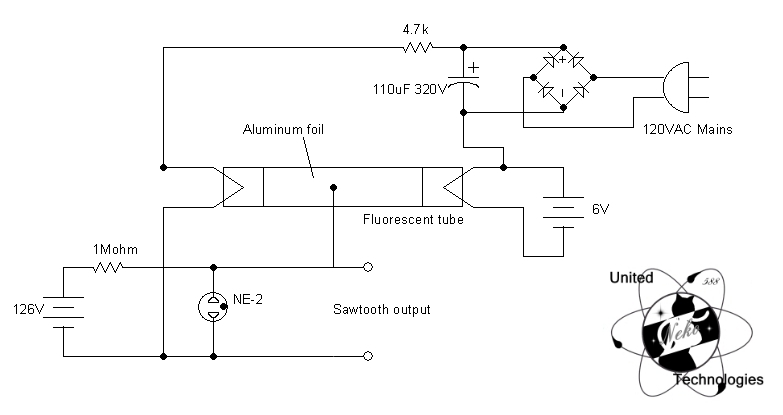
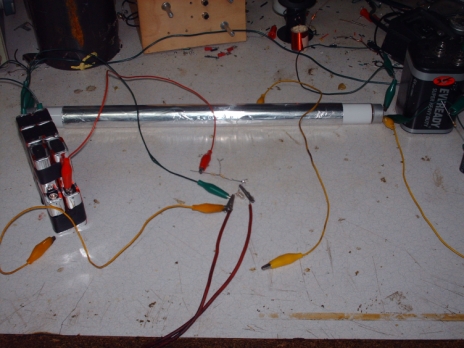
Now we can turn on everything, at which point, nothing will happen; we need a source of a fast high voltage pulse to get the tube ionized enough for it to switch on begin conducting current. A piezoelectric striker commonly used as an igniter for propane barbecue grills can be used. I purchased mine from a local hardware store, as my muse would likely strangle me for disabling a BBQ. It's also possible to 'cannibalize' them from old, derelict BBQ grills that are thrown away as unsafe to use. The piezo striker doesn't commonly fail. To ignite the tube, it's a simple matter of applying power from all the supplies, making sure the filament is running (you should see an orange glow from it if the room is momentarily darkened), and clicking the piezo striker when held near the tube. If done properly, the tube will immediately light. Sometimes you might have to click one or two times. The running apparatus, with the gas ionized, is shown below.
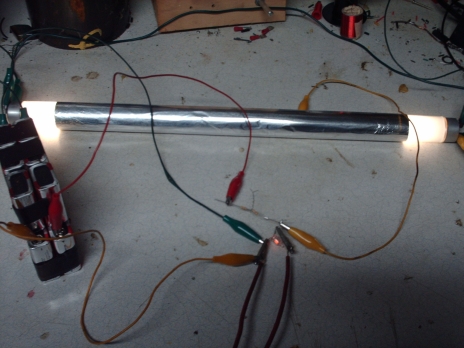
But does it work as a plasma capacitor? Does the relaxation oscillator work?
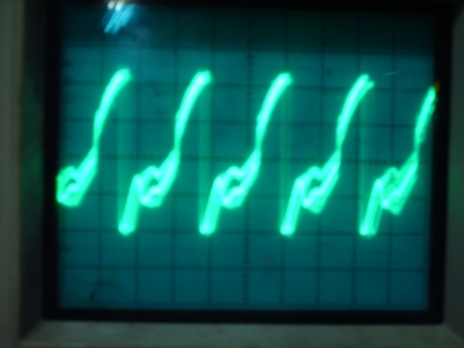
It does, and quite well. As there is no other capacitor in the circuit, the only conclusion we can come to is that the tube is indeed functioning as a capacitor with a single metal plate, and an ionized gas 'plate.' As can be seen, the sawtooth isn't the cleanest waveform. It is rich in odd content, not at all smooth, but it is at least clear what it is. From the above, and from playing around with the setup, it seems as if the sawtooth wave begins its logarithmic rise, is interrupted and even discharges to some degree, with other content appearing in the waveform, then eventually continues its rise, peaks, and discharges. What causes this nonlinear charging waveform? One would assume it is generated in the plasma side of the 'capacitor', and not the foil. Plasmas are known for having 'negative resistance' characteristics under some circumstances. Is that what is happening here?
Calculating the capacitance of the tube is not as simple as it would first seem, at least in this setup. The relaxation oscillator frequency is determined by the values of R and C in the circuit. We could assume R ~ 1Mohm, as the charging resistor is, and solve for C, but there lies the question of how conductive the plasma is. If it has a high resistance value, at least in some part of the charging cycle, the frequency will be changed, and we cannot derive an exact value for C. Off the cuff measurements, matching a known capacitor to the frequency of the oscillator, give a value of somewhere around 0.001uF for the tube and foil used. The tube is manufactured by General Electric, type F15T8-CW.
Another interesting, and perhaps useful effect is illustrated by the waveform below. Pulses of sawtooth relaxation impulses are shown.
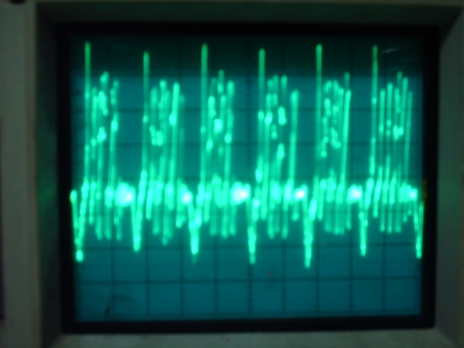
What's interesting about this? How it was produced; the smoothing capacitor across the bridge rectifier feeding the tube's plasma was eliminated. Instead of the plasma being continuously 'lit' by smooth DC, it was now pulsing at 120cps. The sawtooth pulse trains above come in groups of about 5, 120 times per second. If we used half-wave rectified AC, the pulses would only come 60 times per second, and would be separated by a greater time of quiescence. What can we do with this? Well, one wonders if we could use this 'switching capacitor' to make a radio transmitter. Assuming a relaxation oscillator could be made to work with this or a similar setup at RF, if we could modulate the plasma 'keep alive' current at audio, can we send low power CW?
Also, when the plasma 'keep alive' current is reduced, and the tube dims, the relaxation oscillator frequency changes. By modulating the current in this manner, could we make a plasma FM modulator?
One last thing; thinking back to the well known formula E = 1/2 (C x V^2), can we get the capacitive analogue of inductive kickback? When we have a high-value inductor connected to a low voltage current source, and suddenly interrupt the current flow, the collapsing magnetic field induces a very high voltage. This is how automotive ignition coils function, and is pretty well understood. But can we do the same thing, but capacitively, with the 'plasma capacitor'? If we have a capacitance of value C, charged to some voltage V, and we suddenly 'kill' the capacitance by drastically reducing one plate very fast (we 'unlight' the plasma), what happens? E must remain constant; so it would seem that if the capacitance were reduced, V would rise to a high value. Assuming a capacitor of .001uF, as above, charged to say, 500V, we get a stored energy of 0.125mJ. If we suddenly reduce C to 1% of its initial value, or 10pF, assuming E remains constant, with little lost to heat or something else, V would seem to increase to 5000 volts (!). Does it actually work, or is something being missed?
My muse suggests "Additional experimentation is required!" I'd be inclined to agree.
Last updated July 28, 2010
This Web Page Created with PageBreeze Free HTML Editor